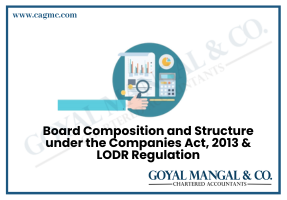 To make the process more effective and investor-friendly, the markets’ regulatory body, the Securities and Exchange Board of India (SEBI), on Wednesday reduced the procedures and documentation requirements for the issue of duplicate securities certificates. There are now operational procedures in place for handling investor service requests for duplicate securities certificates. Here are a brief explanation of the SEBI Procedure & Formats of Duplicate Securities Certificates.
To make the process more effective and investor-friendly, the markets’ regulatory body, the Securities and Exchange Board of India (SEBI), on Wednesday reduced the procedures and documentation requirements for the issue of duplicate securities certificates. There are now operational procedures in place for handling investor service requests for duplicate securities certificates. Here are a brief explanation of the SEBI Procedure & Formats of Duplicate Securities Certificates.
The watchdog has also provided a list of the documentation that security holders must provide when applying for duplicate securities certificates. The most recent action was taken after the regulator examined the procedures used by registrars, share transfer agents (RTAs), issuer corporations, and registrars to issue duplicate securities certificates. In this article, we will discuss the Procedure & format of Documents for the Issuance of Duplicate Securities Certificates.
Quick Look
The provisions relating to the issuance of the Duplicate Share Certificate are covered by Section 46 of the Companies Act, 2013, and Rule 6 of the Companies (Share Capital & Debentures) Rules, 2014. The company may suggest setting up a process for issuing duplicate share certificates and developing a policy for it.
On May 25, 2022, SEBI issued guidelines that simplify the procedure and standardize the document formats required for issuing duplicate security certificates. This step was taken to make the process of issuing duplicate securities more efficient and investor-friendly. Efforts have been made to introduce operational guidelines for processing requests from investors for services related to the issuance of duplicate securities certificates. The Guidelines provide a list of documents that security holders must submit in order to receive duplicate security certificates.
Meaning of Security Certificate
A security certificate is a small data file used as an Internet security technique through which the identity, authenticity, and reliability of a website or Web application are established. A security certificate is used as a means to provide the security level of a website to general visitors, Internet service providers (ISPs), and Web servers. A security certificate is also known as a Digital Certificate or as a Secure Socket Layer (SSL) certificate.
Who are the entities to whom the guidelines on the Issuance of Duplicate Securities Certificates have been made applicable?
The instructions entitled “simplification of the procedure and standardization of document formats for issuing a duplicate security paper” apply to the following entities:
- All SEBI-registered Registrars of Issue and Share Transfer Agents (RTAs)
- All the recognized exchanges
- All companies that are listed on recognized stock exchanges
- All asset management companies (AMCs)
- All investor associations
The criteria for issuing Duplicate Share Certificates
Without the Board/Stakeholders Relationship Committee’s prior approval or without paying the costs the Board/Stakeholders Relationship Committee deems appropriate, a duplicate share certificate may not be produced in place of those that are lost or destroyed. It should not go beyond Rs. 50 per certificate and be given on fair terms, like the provision of backing documentation, indemnification, and payment of the company’s out-of-pocket costs spent while examining the evidence presented, as described in this Policy.
Documents and Procedure to be followed by Securities Holder as per Notification
When applying for Duplicate Securities Certificates, the security holder is required to submit the following documents:
- Copy of FIR (including e-FIR) with details of securities, folio number, distinguishing numerical range, and certificate numbers.
- An advertisement in a widely circulated newspaper relating to the loss of securities
- Submission of an affidavit and bond of indemnity in a format prescribed by the board.
- The requirements under clauses 1 and 2 shall not be deemed to be fulfilled if the value of the securities as on the date of application along with the complete documentation prescribed by the Board does not exceed the number of 5000 rupees.
- The applicant is to calculate the value of the securities on the basis of the closing price of such securities on one of the SEBI-recognized stock exchanges on the day before the date of application.
- The overseas security holder has been permitted to submit a self-declaration regarding the lost/misplaced/stolen security certificate in lieu of the documents mentioned in point 1. This must be duly notarized/ endorsed by the Indian Consulate/Embassy in his country of residence.
- The owner of a certified copy of the security holder’s valid passport and proof of foreign address must also be submitted by the security holder.
Additional Documents from the annexure are to be submitted by the Securities Holder
The following are the additional documents from the annexure are to be submitted by the Securities Holder:
- Form A of the attachment, which is an affidavit for the issuance of duplicate security certificates,
- Form B of the Annex, which is an indemnity for the issue of Duplicate Securities,
- The Appendix C form contains the Confirmation Letter format.
- Investor Service Request Form-4 (ISR 4)
The Guidelines mandate that RTAs or listed companies must strictly follow the formats and documentation set out in the Annex to these Guidelines for all requests for services related to the issuance of duplicate security certificates. It is the duty of the stock exchanges to inform the listed companies of the details of these guidelines and disseminate this information through their official websites.
This circular was issued in support of the powers granted under 2 paragraph 1 letter 11(1) of the SEBI Act, 1992, and the purpose of this circular is to protect the interests of investors and promote the development and regulation of the securities market.
The Process for Obtaining a Duplicate Share Certificate
In the event that the original share certificate is tampered with, ripped, lost, or destroyed, the Shareholder must complete the process and submit the necessary documents to receive a replica. If the company/registrar and share transfer agents are aware of the shareholder’s folio number and the full information of the missing share certificates, the shareholder must tell them of the loss of share certificates. The complete disclosure of the shares for which the duplicate share certificate is requested must be stated in this application.
The following method must be followed in order to produce a duplicate share certificate in place of an original certificate that has been reported lost:
- Submission of Compliant: File a complaint of the lost share certificates with the local police station, mentioning your name, the share certificate number, the distinctive number of the shares, and the folio number, and provide the company with a copy of the acknowledgment of the FIR that bears the seal of the police authorities. A first-class magistrate, notary, or recognized police complainant must properly testify to the copy of it. If the complaint or FIR is in a regional language, a genuine translation into English that has been officially certified by a Notary Public must also be presented with the FIR.
- Letter of Request: Send the properly signed letter asking for the issuance of a duplicate share certificate, referencing the Folio Number and other relevant information on the shares and share certificate. Request letter for issuance of a duplicate share certificate, properly signed by the shareholders. However, in order to locate the share certificates on his end and prevent the costly and time-consuming issuance of duplicate share certificates, the shareholder is urged to conduct a thorough search.
- Advertisements in the Newspaper: The information on the missing share certificate must be published in a newspaper notice or advertising, and a copy of the notice or advertisement must also be provided to the company. If the business needs to reduce its advertising expenses, it can aggregate, say, 4-5 cases and divide the cost among all the owners. However, if there is a pressing necessity, single advertising may be published at the applicant’s expense. A broad notice informing the public of the loss of any share certificates valued at Rs. 10,000 or more must be published in a newspaper distributed in the area where the company’s registered office is located. If no objections are received by the company within the specified period, the company then proposes to think about issuing a duplicate share certificate in place of the missing one. A Shareholder is responsible for covering the costs associated with publishing the general notice.
- Affidavit and Indemnity Bond Execution: Execute Indemnity Bond & Affidavit on non-judicial stamp paper to be acquired solely in the name of the shareholder with a value of Rs. 100 and Rs. 20 that is fully signed by Notary Public/Special Executive Magistrate with the proper stamps & seal affixed along with the registration number. The Indemnity Bond and Affidavit must include information such as Folio No., Certificate No., and Distinctive No. of Shares. The shareholder must sign each page of the indemnity bond and affidavit, and the executors must initial any changes to the document. Affidavits must be attested by a notary, who must also attach the proper notary stamps, their seal, and their registration number.
- Identification and Residency Proof: The copy of the PAN card that is needed as identification, together with one of the documents listed under “Proof of Residence,” such as an electricity bill, phone bill, water bill, ration card, passport, or driver’s license that has been properly notarized or gazetted. A resident’s identification document from the shareholder, properly attested by a notary or officer of the gazette. A person other than a family member must sign the surety form, which must also include a copy of the Pan Card and income proof that has been officially certified.
- Evidence of Identity of Surety: Copy of the Pan Card, Passport, or Driver’s License is required, along with other supporting documents like a salary certificate or pay stub, a copy of the most recent assessment order made by the income tax authorities, a proposed valuation report issued by the revenue authorities, the municipal authorities, or the secretary of the gram panchayat, all of which must be properly attested by a Notary or Gazette officer. The income of the surety must not be less than the current market value of the Shares.
- Identification of Witnesses: The Indemnity Bond should include the entire name, address, and signature of the witnesses and sureties. The individual who signed as a guarantor on the indemnity bond must complete the Surety Form.
Issuance of a Duplicate Share Certificate
After all required documentation has been submitted to the company, the duplicate share certificate must be provided within 15 days.
- After the period specified in the general notice, if any, has passed and the company has not received any objections to the shareholder’s proposal, as applicable, the proposal for the issuance of a duplicate share certificate must be placed at a meeting of the board or the stakeholder relations committee.
- The proposal must be authorized by resolution, which must, among other things, allow the issuance of new share certificates and provide two directors, the secretary, or any other person designated permission to sign the certificates in person and affix the common seal.
- The words “Duplicate issued in lieu of share certificate No….” must be put on the face of the duplicate share certificate, and the term “Duplicate” must be clearly stamped or printed on the share certificate in bold characters.
Intimation to Stock Exchange and Register of Renewed & Duplicate Share Certificates
Additionally, a notice of the issuance of duplicate share certificates and the cancellation of existing share certificates must be issued to all stock exchanges where the company’s shares are listed. Additionally, the following points surrounding the Register of Renewed & Duplicate Share Certificates should be remembered:
- According to the Companies Act, 2013 and the rules there under, information about duplicate share certificates issued must be entered in the Register of Renewed and Duplicate Share Certificates maintained in Form No.SH.2, with the name of the person to whom it is issued, the number and date of the share certificate’s issuance in lieu of which the new certificate is issued, and any necessary changes indicated in the Register of Members by appropriate cross-references in the “Remarks” Section.
- The register must be kept continuously at the company’s registered office or another location where the Register of Members is kept, and it must be in the possession of the company secretary or another individual designated by the Board for this purpose.
- For the purpose of sealing and signing the share certificate, the Company Secretary or another individual lawfully authorized by the Board or the Committee of Directors must validate all entries in the Register.
Conclusion
The Share Certificate serves as conclusive proof that the Shareholder actually owns the Share. A duplicate share certificate is necessary for the event of loss or misplacement of the share certificate and to prevent any financial damage to the company and the shareholders. In the event that a share certificate is lost or misplaced, a duplicate must be issued. The Share Certificate Issuance Process is a Short yet Protracted Process.
Regarding the documents to be submitted by the security holder while applying for the issue of duplicate security certificates, SEBI said that a copy of the FIR, including e-FIR, necessarily containing the details of the securities, folio number, distinguishing numerical range, and certificate numbers will be required. In addition, the publication of an advertisement of the loss of securities in a newspaper of wide circulation and the submission of an affidavit and bond of indemnity in the prescribed format will be required, according to the circular.







